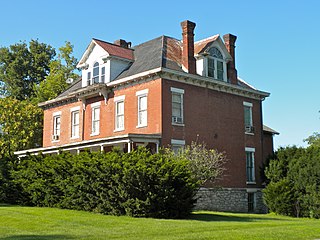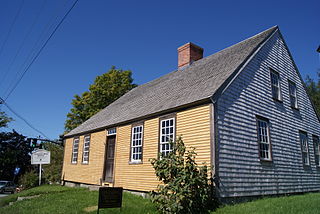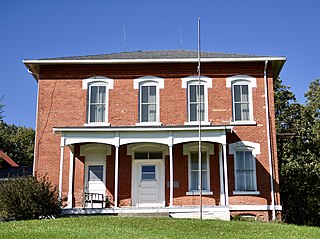
Hannibal Hamlin was an American attorney and politician who served as the 15th vice president of the United States from 1861 to 1865, during President Abraham Lincoln's first term. He was the first Republican vice president.

Nathaniel Cobb Deering was a three-term Republican U.S. Representative from Iowa's 4th congressional district, then in northeastern Iowa.

The Captain Nathaniel Hayden House is a historic house at 128 Hayden Station Road in Windsor, Connecticut. Built in 1763, it is an excellent local example of Colonial brick architecture. It was listed on the National Register of Historic Places in 1988.

The Senator William P. Frye House is a historic house on 453-461 Main Street in Lewiston, Maine. Built in 1874, it is a fine example of Second Empire architecture in the city, designed by local architects Fassett & Stevens for William P. Frye, a mayor of Lewiston and a United States senator. The house was listed on the National Register of Historic Places in 1976.

The Thomas Brackett Reed House is a historic brick duplex house at 30–32 Deering Street in Portland, Maine. Built in 1876, the house was designated a National Historic Landmark in 1975 for its association with Thomas Brackett Reed (1839–1902), Speaker of the House of Representatives. Reed owned and occupied number 32 from 1888 until his death in 1902. He was notable for significantly increasing the power of the House Speaker, introducing a set of rules known as the Reed Rules that still govern debate in that body today.

The Nathaniel Osgood House is a historic house on Maine State Route 136 in Durham, Maine, United States. Built in 1785, early in the town's settlement history, it is a well-preserved example of Federal period architecture. It was listed on the National Register of Historic Places in 1985.

The Spite House, also known as the Thomas McCobb House, is a historic house at Deadman's Point in Rockport, Maine. Built in 1806 in Phippsburg, it is a high quality example of Federal period architecture. It was built by Thomas McCobb as a deliberately elaborate building to exceed in quality the fine house in which he had grown up, which he had lost in a family dispute. It was moved to its current location in 1925, and was listed on the National Register of Historic Places in 1974.

The Hiram Price/Henry Vollmer House is a historic building located on the Brady Street Hill in Davenport, Iowa, United States. It was listed on the National Register of Historic Places in 1983. The home is named for two members of the United States House of Representatives who lived in the house, Hiram Price and Henry Vollmer, who both represented Iowa's 2nd congressional district. The building is now a part of the campus of Palmer College of Chiropractic where it houses the Office of Strategic Development.

The John N. and Mary L. (Rankin) Irwin House is a historic building located in Keokuk, Iowa, United States. It was individually listed on the National Register of Historic Places in 1999. In 2002 it was included as a contributing property in The Park Place-Grand Avenue Residential District.

The E. H. Harrison House is a historic building located in Keokuk, Iowa, United States. It was designed in a combination of Federal, Greek Revival, and Second Empire styles by local architect Frederick H. Moore, and built in 1857 by local builder R.P. Gray. It is believed that this is the first house in Iowa to have a Mansard roof, which is its Second Empire influence. The Federal style is found in the building's large windows, the elliptical doorway arch, the bowed two story front bay, and the brickwork. The Greek Revival style is found in the offset doorway. Its interior features a unique open, two-story, self-supporting staircase that is said to be one of seven in existence in the United States. Additions have been built onto the back of the house, but their dates are unknown.

Cedar Valley Seminary is a historic seminary building currently at N. 7th and Chase Streets in Osage, Iowa. Prior to June 2016, it had been located at N. 6th and Mechanic Streets.

The J. G. Deering House, also known as the Dyer Library/Saco Museum, is an historic house at 371 Main Street in Saco, Maine. Completed in 1870, it is a fine local example of Italianate style. Built for Joseph Godfrey Deering, it was given by his heirs to the city for use as a library. It was listed on the National Register of Historic Places in 1982.
The Squire Ignatius Haskell House is a historic house at 20 Main Street in the center of Deer Isle, Maine. Now home to the Pilgrim's Inn, this wood-frame house was built in 1793 by one of the maritime community's leading men, and is one of its oldest buildings. It was listed on the National Register of Historic Places in 1978.

The Nathaniel Treat House is a historic house at 114 Main Street in Orono, Maine. Probably built in the 1830s, the house is a fine example of transitional Federal-Greek Revival architecture executed in brick. The house was built by Nathaniel Treat, and was in the 20th century home to Charles J. Dunn, chief justice of the Maine Supreme Judicial Court. The house was listed on the National Register of Historic Places in 1973.

The Hannibal Hamlin House is a historic house at 15 5th Street in Bangor, Maine. Built c. 1848–51, this well-preserved Italianate house was the home of U.S. Vice President Hannibal Hamlin from 1862 until his death in 1891. From 1933 until 2007 it served as the official residence of the president of Bangor Theological Seminary. It was listed on the National Register of Historic Places in 1979.

Samuel Nichols House is a historic residence located in rural Muscatine County, Iowa, United States near the town of Nichols. It has been listed on the National Register of Historic Places since 1978.

The Chapman-Hall House is a historic house museum at 270 Main Street in Damariscotta, Maine. Built in 1754 by one of the area's first permanent white settlers, it is the oldest standing house in the town, and one of the oldest in the state. It was listed on the National Register of Historic Places in 1970.

The McCobb–Hill–Minott House is a historic house at 44 Parker Head Road in Phippsburg, Maine. Built in 1774, it is a high quality example of late Georgian architecture, notable for its architecture and its prominent residents, who included Mark Langdon Hill, Maine's first United States Congressman. The house is now the 1774 Inn, and was listed on the National Register of Historic Places in 1977.

The Nathaniel Butterworth House is a historic residence located north of Andrew, Iowa, United States. It is one of over 217 limestone structures in Jackson County from the mid-19th century, of which 101 are houses. The Butterworth house features a five bay symmetrical facade capped by a gable roof. The stones, which were said to have been quarried on this farm, are of various sizes and shapes and are laid in courses. Unlike many of the stone houses in Jackson County, the Butterworth house makes use of Classical entablature and pilasters around the transom and the sidelights of the main entry. The double end chimneys are found on only two other stone houses in the county.

The Audubon County Home Historic District, also known as the Nathaniel Hamlin Park & Museum, is a nationally recognized historic district located south of Audubon, Iowa, United States. During their journey to the West, Mormons camped here in the 1840s. The place became known as Blue Grass Grove because of a legend that they spilled bluegrass seed from their wagons. The Meskwaki tribe used the area as a summer campground for hunting parties until 1886. The county purchased the property in 1890, and built the Renaissance Revival style home as a care facility. The facility stood empty for several years when it was designated as a preservation project to observe the United States Bicentennial. The park is named after Nathaniel Hamlin, one of the first settlers in Audubon County. It was listed on the National Register of Historic Places in 2015.






















